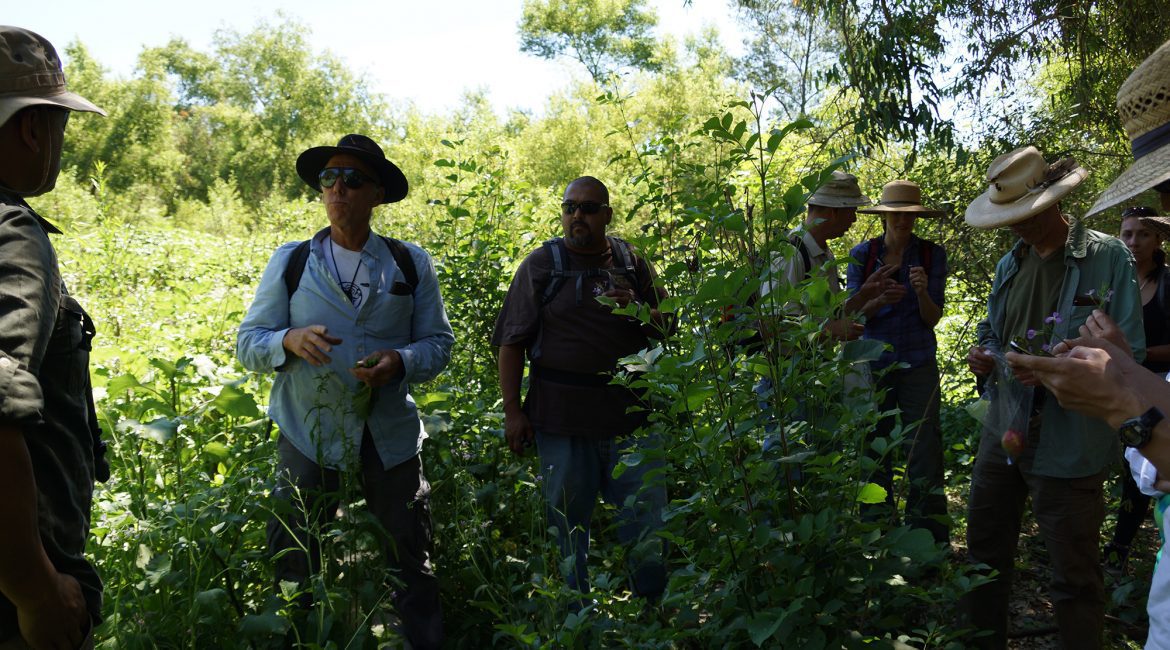Students of ethnobotany should always begin by learning the plants that grow close to home, in their own yard, neighborhood, farm, or town. Master what is right under foot before you worry too much about what is across the country, or on the other side of the world. The more you learn, the more you discover you do not know, especially as you travel around. But it is good to have a solid foundation of knowing those plants that you see most often.
Some time ago, I participated in a survival skills weekend organized by members of Ron Hood’s on-line forum [www.survival.com]. The location was a private wild preserve north of Southern California’s Los Padres National Forest. It was a high desert land with lots of open flatlands, but also steep mountains and a small stream that ran through the area. My part of the event was to teach an introductory class on plant identification, and lead a short walk to see some of the areas useful plants first-hand.
I had only been to the area once before, and I tried to lead a path through the wild area to avoid the many plants that occurred in that area that I had never seen before. Yes, there is always more to learn!And yet, it was clear that some of the most useful wild foods truly are found everywhere, even in this desert locale.
We found cattails, watercress, sedges, rushes, willow, cottonwoods, and even wild celery. Cattails should be familiar to anyone who has ever driven by a wet area in the fall, and seen the brown “hot dogs on sticks” that appear to rise out of the reeds. We had no food to eat from the cattail in August, since the pollen was all gone, the flower spikes were brown, and the shoots were not tender, but fibrous. If we wanted to weave baskets or mats, however, we’d have a large supply of useful material.
Watercress is found world-wide, and about half of our group recognized it. We nibbled on the spicy leaves. When we encountered celery growing in the water, I asked one of the new students, and after a second of looking at it and smelling it, he said “celery!” In fact, celery is remarkably easy to identify in the wild. The leaves appear similar to cultivated celery, and the stalks tend to be rounded, rather than the scalloped shape of commercial celery. But there are the typical veins in the leaf and stalk, and the aroma is unmistakable. Wild celery is a bit more fibrous and bitter than cultivated celery, and is used sparingly in salads, or cooked. Note: Never eat any member of the parsley family unless you are absolutely sure of its identity. Though there are many good foods in this group – such as celery – there are also deadly members, such as poison hemlock (which looks more like parsley).
In the hard-packed soil around our campground, we found small lamb’s quarter and amaranth plants, both of which can be used young in salads, or cooked like spinach. These plants are found world-wide.
Oak trees were abundant in the area, and the acorns were just starting to mature and fall. We also found numerous elder trees in full fruit. As with most of the desert elders, the fruit is tart, though there is obviously some sugar. It made a great trail nibble. I also explained how the elder stems can be hollowed out and used for blowguns, flutes, or straws to revive one’s campfire from the ashes.
Here and there in the clearings we found individual wild cherry bushes, all in fruit. Cherry is a plant that is found widely throughout North America. It is by no means restricted to a desert environment, though it grows much larger in less arid environments. The thin flesh was delicious. I also explained that in the old days Native Americans kept and shelled the seeds, leached out the bitterness, and used it in their various food items. To help identify the plant, each person examined the glossy green leaves with their margin of fine teeth. We also crushed and smelled the leaves to note its characteristic “bitter almond” aroma.
Where the open fields met the low-wooded areas, we found large patches of wild roses, with their beautiful and delicate five-petalled flowers. The stalks, as with all roses, were covered in big thorns, but also full of the small orange-red fruits, known as “rose hips.” These were all at the peak of their ripeness, and were good eaten right off the bush. There was none of the fibrousness inside the fruit that is common with cultivated roses. We just wiped each fruit, cleaned off the flower end of the fruit, and ate them.
On our two hour desert walk, we also found many of the plants found widely throughout Southern California’s deserts and chaparral regions. There were at least four common plants that I’d not seen before and took samples to identify later.
The investigation of ethnobotany is always full of surprises. On one hand, you can never know it all, and even after decades of study, you will encounter strangers that you have never met before – even in your “backyard.” And yet, once you learn some of the basic wild foods that people have used everywhere for centuries, you can go just about anywhere in the world and find these common ones – the common plants that you should all be finding in your backyards and neighborhoods.
WILD FOODS OF THE HIGH DESERT
